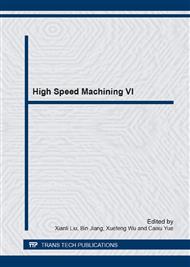p.3
p.9
p.15
p.20
p.26
p.32
p.37
p.42
Experimental Study on Surface Quality at Different Milling Speed of High Volume Fraction SiCp/Al Thin Walled Test-Piece
Abstract:
In order to investigate the influence of milling velocity on surface roughness of the cutting entrance, middle part and cutting exit, high milling experiment for the thin walled test-piece of high volume fraction SiCp/Al composites was preformed with PCD tool. The results indicate that when milling at lower speed 60m/min, the SiCp/Al test-piece is apt to vibrate. As well as, the surface roughness machined test-piece in cutting exit increases obviously and its Ra value reaches 1.721μm, which leads to the inferior surface quality. In conclusion, the surface roughness, either at cutting entrance, middle or at cutting exit, all is a decline trend with the milling speed increasing. Moreover, Ra value of the cutting entrance is the biggest, followed by the middle, and the cutting exit is the smallest.
Info:
Periodical:
Pages:
15-19
Citation:
Online since:
July 2014
Authors:
Price:
Сopyright:
© 2014 Trans Tech Publications Ltd. All Rights Reserved
Share:
Citation:


